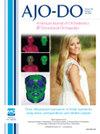Evaluation of a multifunctional orthodontic adhesive incorporating zinc oxide quantum dots
IF 3
2区 医学
Q1 DENTISTRY, ORAL SURGERY & MEDICINE
American Journal of Orthodontics and Dentofacial Orthopedics
Pub Date : 2025-03-22
DOI:10.1016/j.ajodo.2025.02.011
引用次数: 0
Abstract
Introduction
The objective of this study was to further evaluate the long-term antibiofilm and fluorescence properties as well as enamel demineralization prevention ability, removal efficiency, and biocompatibility of an orthodontic adhesive modified with zinc oxide quantum dots (ZnQDs).
Methods
ZnQDs were synthesized and characterized by transmission electron microscope and fluorescence observation. Minimal inhibitory concentration and minimum bactericidal concentration of ZnQDs against Streptococcus mutans were evaluated. ZnQDs (20% by weight) were incorporated into Transbond XT adhesive paste to form the multifunctional orthodontic adhesive (quantum dots adhesive 20 [QDA20]). Long-term antibiofilm capability and fluorescence properties were evaluated after saliva storage aging. A biofilm demineralization model was constructed, and the enamel demineralization degree was evaluated by color analysis, Raman analysis and microcomputed tomography. Bracket bonding and debonding procedures were performed on a head simulator, and the effectiveness of adhesive removal was assessed. Subcutaneous tissue, blood, and organ compatibility assays were performed on a rat subcutaneous tissue implant model.
Results
ZnQDs had a diameter of approximately 5 nm, and the minimal inhibitory concentration and minimum bactericidal concentration against S mutans were 0.32 and 1.25 mg/mL. ZnQDs showed long-lasting antibiofilm and fluorescent properties and could reduce the color change and mineral loss of enamel during the biofilm demineralization process. On the head simulator, QDA20 could help the operator remove adhesive more thoroughly without damaging enamel. Histologic analysis of subcutaneous tissue and organs, and blood analysis proved that QDA20 was well-biocompatible.
Conclusions
ZnQDs showed excellent antibiofilm and fluorescent properties and thus could be a multifunctional adhesive to overcome the 2 major challenges of enamel demineralization and difficulty in recognizing adhesives during fixed orthodontic treatment.
评估含有氧化锌量子点的多功能正畸粘合剂。
摘要:本研究旨在进一步评价氧化锌量子点(ZnQDs)改性正畸胶粘剂的长期抗生物膜和荧光性能、牙釉质脱矿预防能力、去除效率和生物相容性。方法:合成锌量子点,采用透射电镜和荧光观察对其进行表征。测定了ZnQDs对变形链球菌的最低抑菌浓度和最低杀菌浓度。将重量为20%的ZnQDs加入Transbond XT黏合剂中,制成多功能正畸黏合剂(量子点黏合剂20 [QDA20])。对唾液贮存老化后的长期抗菌膜性能和荧光特性进行评价。建立生物膜脱矿模型,通过颜色分析、拉曼分析和显微计算机断层扫描评价牙釉质脱矿程度。在头部模拟器上进行支架粘接和脱粘操作,并评估粘接去除的有效性。对大鼠皮下组织植入物模型进行皮下组织、血液和器官相容性测定。结果:ZnQDs直径约为5 nm,对S mutans的最小抑菌浓度和最小杀菌浓度分别为0.32和1.25 mg/mL。ZnQDs具有持久的抗生物膜和荧光特性,可以减少生物膜脱矿过程中牙釉质的颜色变化和矿物质损失。在头部模拟器上,QDA20可以帮助操作员更彻底地去除粘合剂,而不会损坏牙釉质。皮下组织和器官的组织学分析以及血液分析证明QDA20具有良好的生物相容性。结论:ZnQDs具有良好的抗菌膜和荧光特性,可作为一种多功能粘接剂,克服固定正畸治疗中牙釉质脱矿和粘接剂识别困难的两大难题。
本文章由计算机程序翻译,如有差异,请以英文原文为准。
求助全文
约1分钟内获得全文
求助全文
来源期刊
CiteScore
4.80
自引率
13.30%
发文量
432
审稿时长
66 days
期刊介绍:
Published for more than 100 years, the American Journal of Orthodontics and Dentofacial Orthopedics remains the leading orthodontic resource. It is the official publication of the American Association of Orthodontists, its constituent societies, the American Board of Orthodontics, and the College of Diplomates of the American Board of Orthodontics. Each month its readers have access to original peer-reviewed articles that examine all phases of orthodontic treatment. Illustrated throughout, the publication includes tables, color photographs, and statistical data. Coverage includes successful diagnostic procedures, imaging techniques, bracket and archwire materials, extraction and impaction concerns, orthognathic surgery, TMJ disorders, removable appliances, and adult therapy.

 求助内容:
求助内容: 应助结果提醒方式:
应助结果提醒方式:


